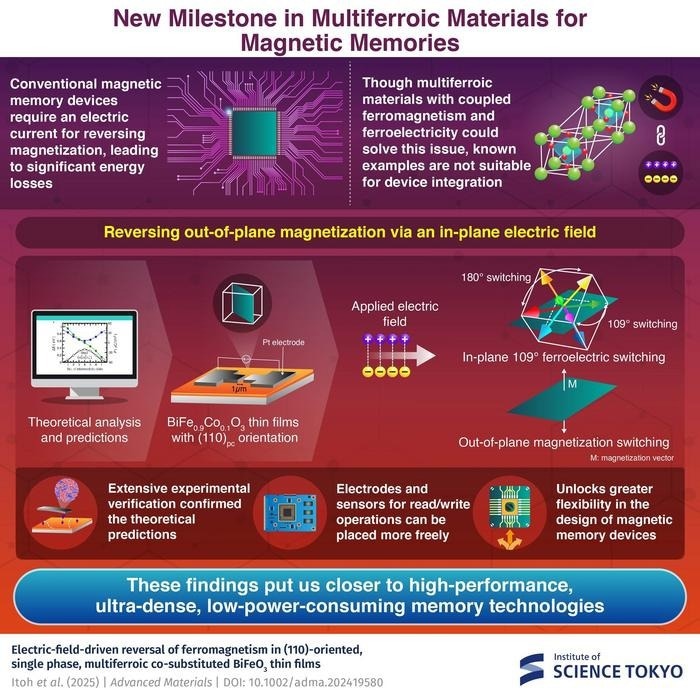Reviewed by Lexie CornerJun 2 2025
A research team led by Assistant Professor Kei Shigematsu and Specially Appointed Associate Professor Hena Das, along with graduate student Takuma Itoh and Professor Masaki Azuma from the Institute of Science Tokyo, Japan, and Sumitomo Chemical Co. Ltd., has made progress in the study of multiferroic materials.
 The discovery of electric-field-induced magnetization reversal perpendicular to the electric field in multiferroic materials could revolutionize memory design, enabling more space- and energy-efficient devices to match increasing technological demands. Image Credit: Institute of Science Tokyo
The discovery of electric-field-induced magnetization reversal perpendicular to the electric field in multiferroic materials could revolutionize memory design, enabling more space- and energy-efficient devices to match increasing technological demands. Image Credit: Institute of Science Tokyo
As digital systems demand more storage and faster data access, magnetic memory technologies have gained attention. However, conventional magnetic memory systems have a drawback: they use electric currents to generate magnetic fields for reversing magnetization. This process leads to energy loss as heat.
To address this inefficiency, researchers are exploring ways to reduce power consumption in magnetic memory without sacrificing performance.
Multiferroic materials, which show both ferroelectric and ferromagnetic properties, are seen as promising candidates for future memory technologies. In theory, magnetization in these materials could be controlled by electric fields rather than currents, reducing energy loss during switching.
Progress has been slow, partly due to the belief that the electric field must align with the direction of magnetization reversal for the device to work.
The team studied thin films of BiFe0.9Co0.1O3, a rare multiferroic material that exhibits both ferromagnetism and ferroelectricity at room temperature. Their research showed, for the first time, that magnetization components perpendicular to an applied electric field can be reversed.
They achieved this by creating BiFe0.9Co0.1O3 thin films with an uncommon crystallographic orientation. Through both theoretical analysis and experiments, they found that an electric field applied parallel to the film surface could reverse magnetization in a perpendicular direction. This suggests that the angle of polarization switching plays a key role in controlling the direction of magnetization reversal.
Earlier designs for multiferroic memory assumed that electric fields and magnetization reversal had to be aligned. This new finding challenges that assumption. It may lead to more flexible device designs, where electrodes and sensors can be placed in different configurations.
Such design flexibility could lead to more efficient utilization of the unique properties of BiFe0.9Co0.1O3, potentially enhancing device performance. Moreover, in memory technology, higher integration density is crucial, and increased design flexibility directly supports that goal.
Kei Shigematsu Shigematsu, Assistant Professor, Institute of Science Tokyo
Higher integration densities in memory devices could eventually lead to electronic systems that consume less power while offering improved performance and storage capacity.
Shigematsu added, “We anticipate this breakthrough to significantly advance the development of next-generation magnetic memory devices, contributing to the realization of high-performance, ultra-dense memories.”
As energy demands grow and electronic devices become more widespread, improving space efficiency and reducing power consumption remain important goals. This study is an important step toward using multiferroic materials to develop more energy-efficient and sustainable digital technologies
Journal Reference:
Itoh, T., et al. (2025) Electric-Field-Driven Reversal of Ferromagnetism in (110)-Oriented, Single Phase, Multiferroic Co-Substituted BiFeO3 Thin Films. Advanced Materials. doi.org/10.1002/adma.202419580